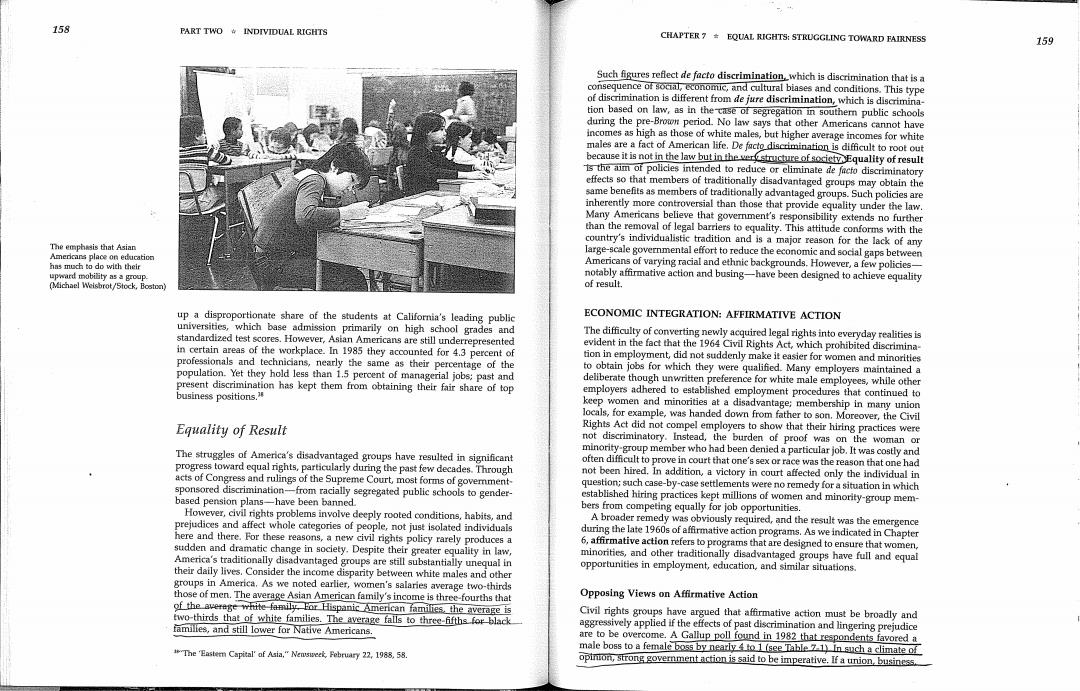正在加载图片...

158 PART TWO INDIVIDUAL RIGHTS CHAPTER 7 EQUAL RIGHTS:STRUGGLING TOWARD EAIRNESS 159 Such figures reflect de facto discrimination,which is discrimination that is a consequence of social,economic,and cultural biases and conditions.This type of discrimination is different from de jure diserimination,which is discrimina- tion based on law,as in the case of segregation in southern public schools during the pre-Bromn period.No law says that other Americans cannot have incomes as high as those of white males,but higher average incomes for white males are a fact of American life.Defact discrimination is difficult to root out because it is not in the law but in the verfstructure of society Equality of result ts the aim of policies intended to reduce or eliminate de facto discriminatory effects so that members of traditionally disadvantaged groups may obtain the same benefits as members of traditionally advantaged groups.Such policies are inherently more controversial than those that provide equality under the law. Many Americans believe that goverment's responsibility extends no further than the removal of legal barriers to equality.This attitude conforms with the The emphasis that Asian country's individualistic tradition and is a major reason for the lack of any large-scale governmental effort to reduce the economic and social gaps between has much to do with their Americans of varying racial and ethnie backgrounds.However,a few policies- upward mobility as a group. notably affirmative action and busing-have been designed to achieve equality (Michael Weisbrot/Stock,Boston) of result up a disproportionate share of the students at California's leading public ECONOMIC INTEGRATION:AFFIRMATIVE ACTION universities,which base admission primarily on high school grades and standardized test scores.However,Asian Americans are still underrepresented The difficulty of converting newly acquired legal rights into everyday realities is in certain areas of the workplace.In 1985 they accounted for 4.3 percent of evident in the fact that the 1964 Civil Rights Act,which prohibited discrimina- professionals and technicians,nearly the same as their percentage of the tion in employment,did not suddenly make it easier for women and minorities population.Yet they hold less than 1.5 percent of managerial jobs;past and to obtain jobs for which they were qualified.Many employers maintained a present discrimination has kept them from obtaining their fair share of top deliberate though unwritten preference for white male employees,while other business positions. employers adhered to established employment procedures that continued to keep women and minorities at a disadvantage;membership in many union locals,for example,was handed down from father to son.Moreover,the Civil Equality of Result Rights Act did not compel employers to show that their hiring practices were not discriminatory.Instead,the burden of proof was on the woman or The struggles of America's disadvantaged groups have resulted in significant minority-group member who had been denied a particular job.It was costly and progress toward equal rights,particularly during the past few decades.Through often difficult to prove in court that one's sex or race was the reason that one had acts of Congress and rulings of the Supreme Court,most forms of govemment- not been hired.In addition,a victory in court affected only the individual in sponsored discrimination-from racially segregated public schools to gender- question;such case-by-case settlements were no remedy for a situation in which based pension plans-have been banned. established hiring practices kept millions of women and minority-group mem- However,civil rights problems involve deeply rooted conditions,habits,and bers from competing equally for job opportunities. prejudices and affect whole categories of people,not just isolated individuals A broader remedy was obviously required,and the result was the emergence here and there.For these reasons,a new civil rights policy rarely produces a during the late 1960s of affirmative action programs.As we indicated in Chapter sudden and dramatic change in society.Despite their greater equality in law, 6,affirmative action refers to programs that are designed to ensure that women, America's traditionally disadvantaged groups are still substantially unequal in minorities,and other traditionally disadvantaged groups have full and equal their daily lives.Consider the income disparity between white males and other opportunities in employment,education,and similar situations. groups in America.As we noted earlier,women's salaries average two-thirds those of men.The average Asian American family's income is three-fourths that Opposing Views on Affirmative Action of the average white family.For Hispanic American families.the average is two-thirds that of white families.The average falls to three-fifths for black Civil rights groups have argued that affirmative action must be broadly and tamilles,and still lower for Native Americans. aggressively applied if the effects of past discrimination and lingering prejudice are to be overcome.A Gallup poll found in 1982 that respondents favored a The Eastem Capital'of Asia,"Fobruary 22,1988,58 male boss to a female boss by nearly 4to 1 (see Table 7-1)In such a climate of opinion,strong government action is said to be imperative.If a union,business